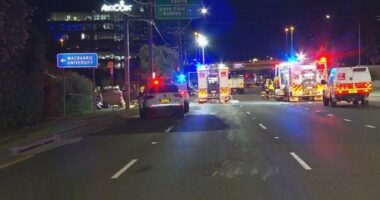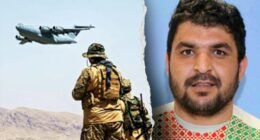Share this @internewscast.com
It began with shouts.
Run, run! The Serbian army has entered! Srebrenica is falling! Run!
“My heart is wounded.”

Rukija Avdić tearfully gazes at photographs of her husband and brother, both victims of the Srebrenica massacre. She recounts losing around 40 family members to the war. Source: SBS News
She last saw them on 11 July 1995 when Bosnian Serb forces under General Ratko Mladić entered the small mountain town, which was then a United Nations safe zone.
In 2017, Mladić was found guilty of war crimes, crimes against humanity and genocide.
The fall of Srebrenica
“When I saw and heard the screams, I ran down the stairs and quickly grabbed the children. I thought they were going to burn us alive.”
“When night fell, my husband appeared. He wanted to see where I was, to see the children, to say goodbye. My brother was there too,” Avdić says.
“My husband said: ‘Rukija, please, take care of yourself. Here, take this ring from my finger. Take care of the children. We may never see each other again. May Allah help you.’
After a night in Potočari, she recalls the chilling words of the man who to this day remains in prison in the Hague as a war criminal.

The second day of the trial for Bosnian Serb military commander General Ratko Mladic took place at the Yugoslav war crimes tribunal in The Hague, Netherlands in 2012. Source: SBS News / AP
“Mladić came and spoke. I saw him, heard his voice,” Avdić says.
For five years, Avdić and her four young children lived in tents. They moved into an abandoned home in central Bosnia before coming to Australia in 2000.

Refugees in the Tuzla camp, after being displaced from Srebrenica and surrounding Bosniak villages. Source: Getty / Patrick Robert – Corbis/Sygma via Getty Images
Remains found decades later
Two years earlier, she had also buried her twin brother.
Every year, more and more bodies are found. Even after 30 years, many haven’t been identified.
“He wanted to gather four stones to bring them back to Australia for his sisters, his brother, and himself to have something to remember that day by. To never forget it. It was very hard for them.”

Victims of the Srebrenica genocide are buried at the Memorial Center in Potocari, Bosnia. Source: AAP / Darko Bandic/AP
War and the collapse of Yugoslavia
For centuries, Serbs, Croats and Muslims across the socialist bloc lived together but when Yugoslavia collapsed, fighting broke out between the ethnic groups.
Thousands were sent to concentration camps, where there were reports of killing, torture and starvation.

Malnourished Croatian and Bosnian Muslim prisoners of war in Manjaca, the largest Serbian concentration camp, 1992. Source: Getty / Sovfoto/Universal Images Group via Getty
Avdić says she had been living “a good life” in the town of Osat, about 20km east of Srebrenica, until war came to her doorstep. She was pregnant with her fourth child at the time.
Avdić was among the tens of thousands of people who left their homes for Srebrenica believing it to be safer.
They were not permitted to use force except in self defence and were later found to have been partly responsible for some of the deaths in Srebrenica.
‘No peace without justice’: The war crimes tribunal
“I relied on my experience both doing the Nazi war crimes work and my work at the National Crime Authority to design the prosecutor’s office.”

Graham Blewitt (front right), with the judges and prosecutors of the International Criminal Tribunal for the Former Yugoslavia in 1994. Credit: Supplied
Once set up, Blewitt says they started investigating and prosecuting war crimes.
“Within a few days, the reports started to gather momentum and it became very clear that there was something very serious happening in Srebrenica,” he says.
At that stage, we had no idea that it was going to turn into a genocide. But we realised it was serious enough that we needed to get a team on it straight away.
“We were able to identify both the primary grave sites and the secondary sites, and we decided to carry out exhumations of the bodies in those grave sites.”
“Our view was that you can’t have peace without justice and they were the primary persons responsible for the genocide, so they had to be prosecuted.”
Defining genocide
Milošević was found dead in his cell in the Hague while on trial in 2006.

Graham Blewitt holding the indictment for the Slobodan Milošević, then the Serbian President, in 1999. Credit: Supplied
The ICTY determined the mass killings of Bosnian Muslim men and boys from Srebrenica constituted the crime of genocide.
“Looking at Srebrenica, what the Bosnian Serbs were trying to do and in fact did do, was to kill all the men and boys from Srebrenica, and there were thousands of them.
In our view that met the criteria for the definition of genocide and that then led to the charge genocide being brought.
“Something I’m very proud of being able to have been involved in.”
Remembering the victims
This story was produced in collaboration with SBS Bosnian.











